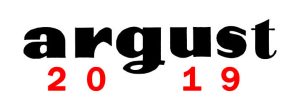 This is an Argoflex Forty, a medium format Psuedo-TLR camera made by Argus Inc. of Ann Arbor, MI, between the years of 1950 and 1954. This is an earlier model as later versions dropped the “Argoflex” name and became simply, the Argus 40. Other than the name change, the two cameras are identical. The Argoflex Forty resembles a regular Twin Lens Reflex camera in that it has a waist level viewfinder covered by a hood and two lenses on the front of the camera. The difference is that unlike a true TLR, the viewfinder on this camera is of the “Brilliant” type, which means it is not coupled to the taking lens, and does not show an accurately focused image. Cameras of this type are nothing more than simple scale focus box cameras, with a very large and bright viewfinder on top. This model was a step up from the Argus Seventy-Five which also had a brilliant finder, but was fixed focus and had only a single shutter speed.
This is an Argoflex Forty, a medium format Psuedo-TLR camera made by Argus Inc. of Ann Arbor, MI, between the years of 1950 and 1954. This is an earlier model as later versions dropped the “Argoflex” name and became simply, the Argus 40. Other than the name change, the two cameras are identical. The Argoflex Forty resembles a regular Twin Lens Reflex camera in that it has a waist level viewfinder covered by a hood and two lenses on the front of the camera. The difference is that unlike a true TLR, the viewfinder on this camera is of the “Brilliant” type, which means it is not coupled to the taking lens, and does not show an accurately focused image. Cameras of this type are nothing more than simple scale focus box cameras, with a very large and bright viewfinder on top. This model was a step up from the Argus Seventy-Five which also had a brilliant finder, but was fixed focus and had only a single shutter speed.
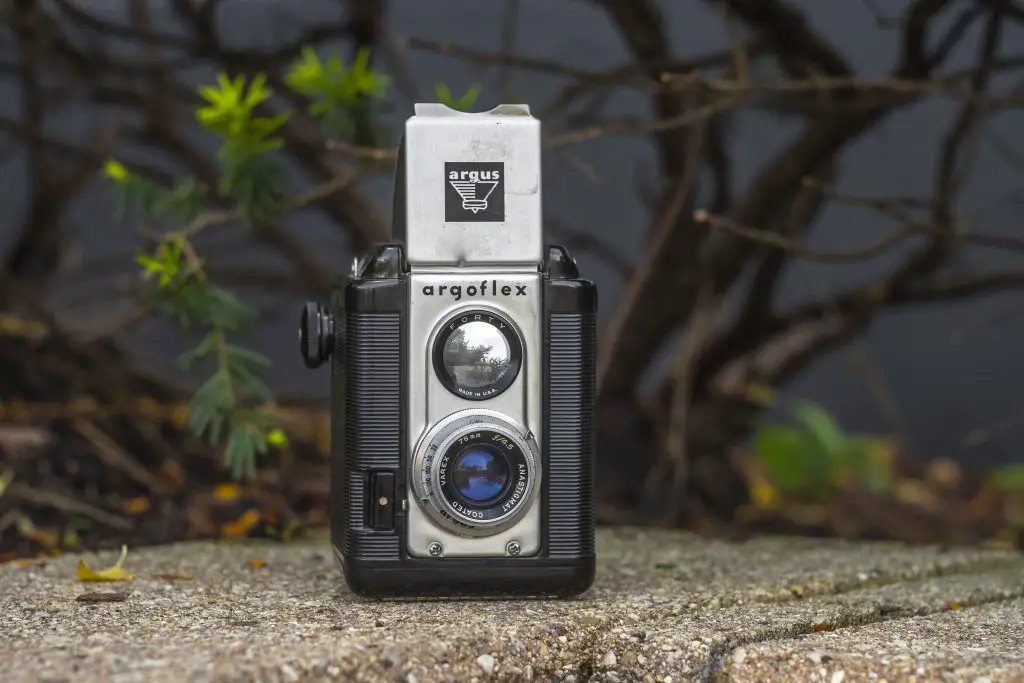 Film Type: 620 Roll Film (twelve 6cm x 6cm exposures per roll)
Film Type: 620 Roll Film (twelve 6cm x 6cm exposures per roll)
Lens: 75mm f/4.5 Varex Anastigmat coated 3-elements
Focus: 3.5 feet to Infinity
Viewfinder: Waist Level Brilliant Viewfinder
Shutter: Argus (Probably Wollensak Alphax) Leaf
Speeds: B, 1/25 – 1/150 seconds
Exposure Meter: None
Battery: None
Flash Mount: Argus 76 Flashgun Mount, M & F Sync (all speeds), X Sync (1/25)
Weight: 618 grams
Manual: http://www.cameramanuals.org/argus/argus_forty.pdf
How these ratings work |
The Argoflex Forty was an in between model in Argus’s lineup of twin lens medium format cameras. It upgraded the Seventy Five with a focusing lens, a 4 speed shutter, and a full range of aperture f/stops. It’s compact body, large and bright brilliant finder, and sharp 3-element lens produce excellent images. This is a very underrated camera that is easy and fun to use, and considering the cheap prices they go for on the used market, offer an excellent value for the collector/user. | ||||||
| Images | Handling | Features | Viewfinder | Feel & Beauty | History | Age | |
| 2 | 2 | 0 | 1 | 1 | 1 | 30% | |
| Bonus | +1 for unexpected excellence, this is a fun camera to use that delivers terrific photographs | ||||||
| Final Score | 10.1 | ||||||
My Thoughts
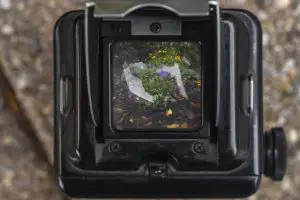
There are certain cameras that collectors almost automatically ignore. Those that were so common, there seem to be an endless supply of them on eBay, at estate sales, in thrift stores, and any other place where vintage cameras lurk.
Argus’s lineup of “pseudo-TLRs” seem to fall into that category, with the most common model being the Seventy-Five. The prefix “pseudo” in front of TLR is reserved for generally lower end twin lens cameras, in which the top, or viewing lens is not coupled to the bottom, or taking lens, and cannot show an accurate representation of what would be captured in film. Cameras of this type are sometimes also called “Brilliant” cameras as the view through the viewfinder is often very bright and easy to use, because there is no ground glass or aperture to reduce the light.
Pseudo-TLRs are not inherently bad, they’re just more basic, some more basic than others. I’ve gotten some terrific results from the previously mentioned Seventy-Five which has a single shutter speed, and fixed focus, and the Voigtländer Brillant which in the example I have, came with a 2-speed shutter, and a focusing lens.
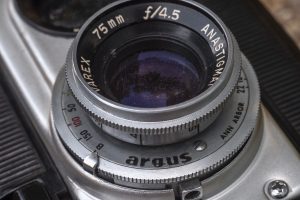
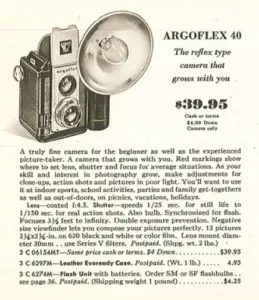
The Argoflex Forty is a less common Pseudo-TLR produced by Argus which doesn’t seem to show up nearly as often as the Seventy-Five. It was considered a step up from that model, but below their top of the line “true” TLR, the Argoflex EF. Selling at a price of $39.95, this compares to about $425 today.
It was only produced for four years from 1950 to 1954, making it one of the less common Argus models. It’s name changed from Argoflex Forty to Argus 40 at some point although the features of the camera remained the same. It’s feature set more closely matches the Voigtländer Brillant in that it has a focusing lens, a 4-speed shutter, and a full selection of aperture f/stops.
The main body of the camera is solid Bakelite with a stamped metal front panel and viewfinder lid. The camera is more compact than a traditional TLR and weighs 618 grams which makes it much easier to hold single handed. Although I would still recommend some kind of neck or wrist strap, you could easily carry this camera around single handed without fear of dropping it.
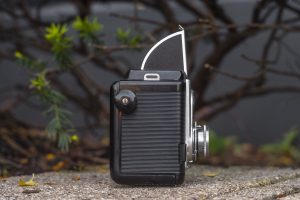
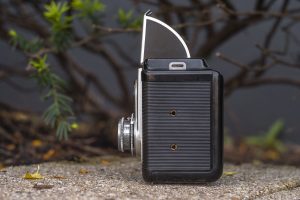
Each side of the camera has a single feature, on the left, is the film advance knob, and the right are two ports for the Argus 76 flash gun. This style of flash is the only one that’s compatible and uses flashbulbs that are synchronized at all shutter speeds.
There are loops on either side for securing a strap that likely came with the camera when it was new. This is a departure from the strap for the Argus Seventy-Five which is permanently attached, a feature of that camera I never enjoyed.
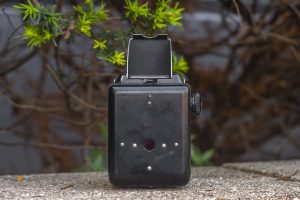
The back of the camera is smooth metal and has a red window for seeing exposure numbers printed on the backing paper of film. To open the rear door of the camera, there is a simple metal latch near the top of the door. It is held on with only friction, so simply pull back on it and it swings down.
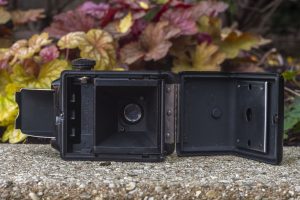
Argus was one of the biggest non-Kodak supporters of Kodak’s 620 format of roll film and as such, this camera requires 620 spools to work. Many people will try to file or trim down plastic 120 spools to fit into 620 cameras, but I’ve always been a fan of using real 620 spools and hand rolling 120 film onto them, so that’s what I did with this camera. Even though you may get a filed down 120 spool to fit, I’ve tried it before and it never seems to transport smoothly. Usually something binds up or you run into other problems.
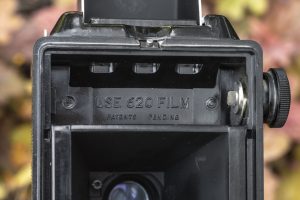
Despite the need for 620 film, the Argoflex Forty is quite an easy to use camera. It is both smaller and weighs less than most true twin lens cameras. The shutter release is large and conveniently located right where the photographer’s right index finger falls. The camera has double image prevention which locks the shutter release after each image. For intentional double exposures, there is a small manual cocking lever to the right of the shutter release that will allow you to override the safeguards and double expose your images. With it’s large and bright viewfinder and comfortable shutter release, it’s quite simple to compose images with the Argoflex Forty.
 Each of the aperture f/stops, shutter speed, and focus distance scales has a red setting at f/8, 100, and 25 feet which when combined with the 75mm Varex lens’s wide depth of field means that anything 12 feet to infinity will be in focus using 100 speed film in average light.
Each of the aperture f/stops, shutter speed, and focus distance scales has a red setting at f/8, 100, and 25 feet which when combined with the 75mm Varex lens’s wide depth of field means that anything 12 feet to infinity will be in focus using 100 speed film in average light.
If you need more range for closer objects and are in bright sunlight, with the focus scale set to 10 feet and an aperture of f/16, everything from 5.5 feet to 59 feet is in focus making candid shots at an outdoor picnic very quick and easy to get. A depth of field chart from the camera’s user manual is to the right if you’d like to look up other focus distance combinations.
This was a camera designed for the amateur who didn’t know much about photography, but still demanded sharp and nicely rendered photographs. Everything I’ve seen suggests that it should have accomplished this in spades, but I guess I wouldn’t know until I took the time to shoot some film in it.
My Results
For my first roll through the Argoflex, I took the time to hand roll a fresh roll of Kodak Ektar 100 onto 620 spools. I use the method discussed in this video posted by the Film Photography Project. Although there are other methods, this works well for me and I can do a whole roll in just about 90 seconds in a film changing bag while sitting in my living room watching TV. Using a 100 speed film in the Argoflex Forty is a smart move, especially if you plan on using Sunny 16, as that speed falls right in the sweet spot of speeds that this camera is capable of.
It’s a good thing I wasn’t developing any other rolls of 120 film when I developed the roll from the Argoflex, because when I saw the images on it after pulling the film out of the tank, I would have had a hard time believing the Argus shot these images.
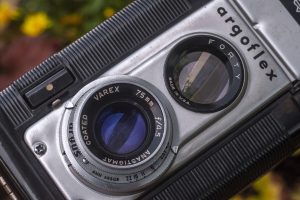
The Varex lens on this camera is credited to Argus, but since previous Argus TLRs like the Argoflex EF used Wollensak designed lenses and shutters, I have a sneaking suspicion that this Varex may have been built by Wollensak as well, as these images are spectacular and easily on par with other Wollensak lens TLRs like the ANSCO Automatic Reflex or Ciro Flex Model D.
Regardless of who made the lens, the images from this camera were razor sharp and the lens coating paired very well with the vibrancy of fresh Ektar 100 film. I noticed only a small amount of softness near the corners, but no significant vignetting, which is surprising, given the lens’s 3-element construction.
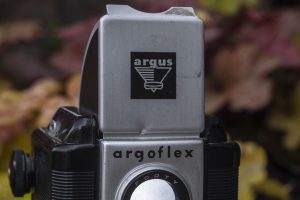
I missed focus on a couple of images, but otherwise was spot on in most of them. What’s most impressive though is how a relatively basic “Pseudo-TLR” like the Argus Forty can produce such splendid shots. This was a camera that anyone who took the time to use would be rewarded with consistently excellent shots. The large and bright brilliant viewfinder, combined with the 4 speed shutter, adjustable iris, and full range of focus make for an extremely capable camera that many collectors today likely would snub their noses at.
Let me say this simply, the Argoflex Forty is an extremely underrated camera. I liked the Seventy-Five, but I LOVE the Forty! These cameras go for cheap on the used market today, so if you ever have an opportunity to pick one up, definitely do it. You can thank me later!
Related Posts You Might Enjoy
External Links
http://camera-wiki.org/wiki/Argus_40
https://photojottings.com/argus-argoflex-forty-review/
https://mikeeckman.com/photovintage/vintagecameras/argoflex40/index.html
http://www.deansphotographica.com/deans_of_idaho/old_stuff_pages/argus40/argus40.html
https://www.nickcarverphotography.com/blog/tag/argus-40/
https://seeker312.wordpress.com/2009/09/08/argus-argoflex-forty/
https://www.photo.net/discuss/threads/a-surprising-american.493988/

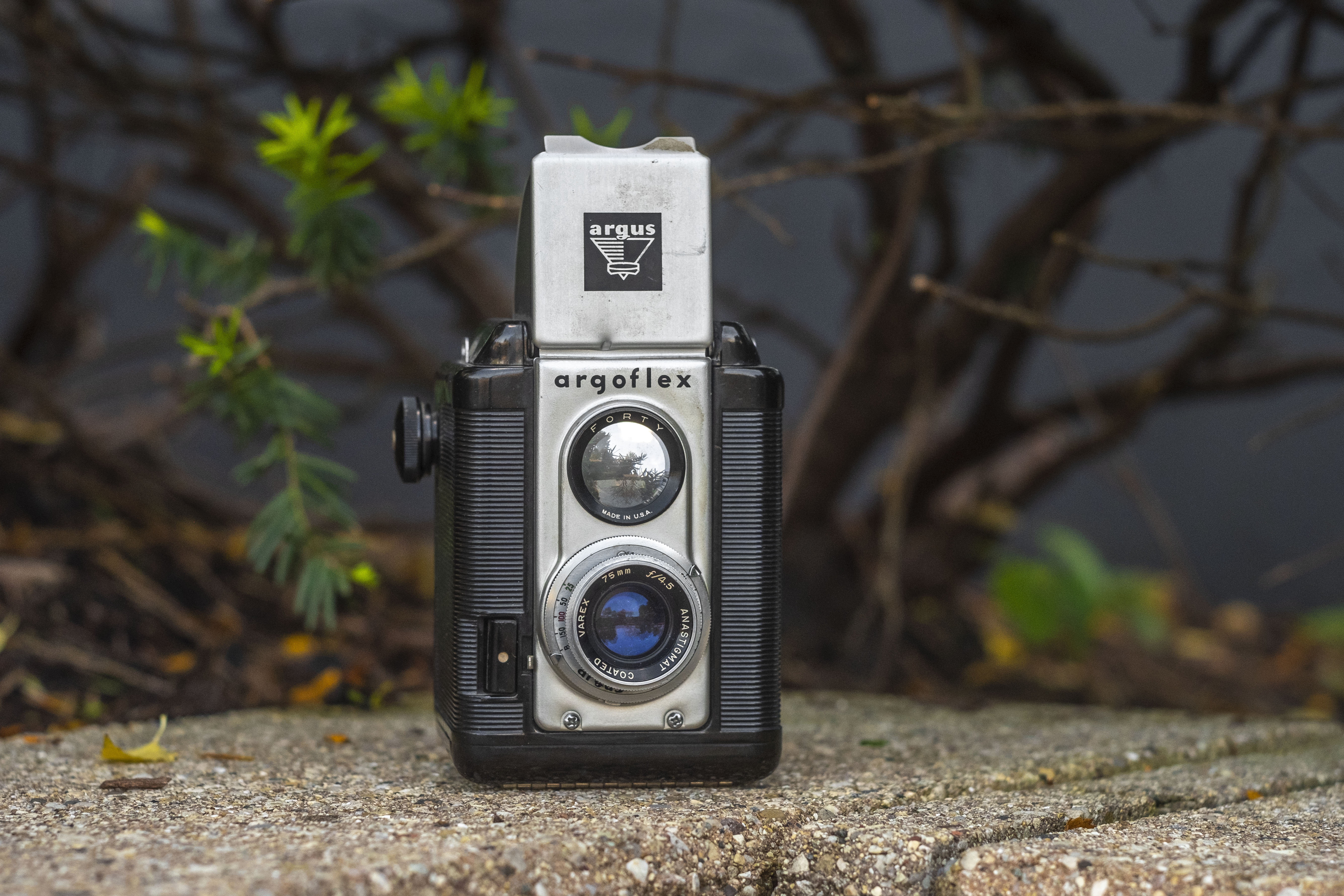
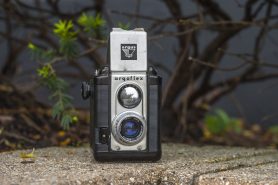









OK — now this is on the top of my “next vintage camera to get” list!!! I have had poor luck with the true TLRs that I have picked up for cheap — not in very usable condition…. Great pics….
Definitely a Sleeper camera if ever there was one, if it took 120 film straight out of the box, it would be a slam dunk for the best medium format camera value out there. Even with the slight hiccup in format, this simple camera has literally made me exclaim wow when seeing the developed film. And the amazing brilliant finder actually seems to make the scene in the frame look more vibrant and jumpy than it actually is!
Thanks for the kind words. I agree that if this supported 120 film natively, it would push it into a “MUST HAVE” camera, but as it is, respooling 120 onto 620 spools takes me less than 2 minutes in a film changing bag.
Hi Mike,
In your review, you mention that the back of the camera is smooth plastic. Actually, it’s a solid piece of aluminum and it’s thick enough that, with a dremel tool and grinding bit, you can easily cut two grooves to allow fitting 120 spools on the supply side without having to trim the spools or respool onto 620 spools. However, you may have to cut a tiny notch on the edge of the 120 spool to clear the spindle. I own two of these cameras and have gotten excellent images from them. As I’ve gotten older, my eyes have difficulty judging focus on dim images and I really appreciate the brilliant finder. I use an app on my phone to measure distance to the subject for focusing and metering.
Gary
Well by golly, you’re right. I don’t know why I thought it was plastic! I have corrected my mistake. As for trimming the camera to use 120 spools, you’re probably right, but as I’ve said in every other 620 film camera review, I find the 90 seconds it takes to roll 120 film onto a 620 spool to be preferable to other options.
There is one difference I know of between the Argoflex 40 and the later variant. The Argoflex has a chrome metal advance knob. The later 40 uses a black plastic knob that doesn’t have the same visual appeal.
Good catch! I know the Kodak Brownie Hawkeye has a difference between metal and black plastic knob between early and later versions. Most people usually prefer the metal knobs!